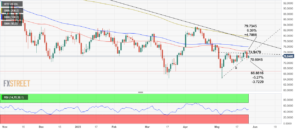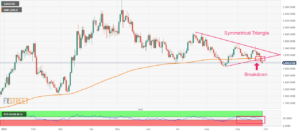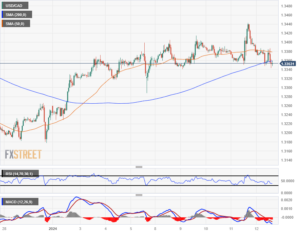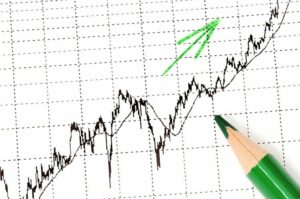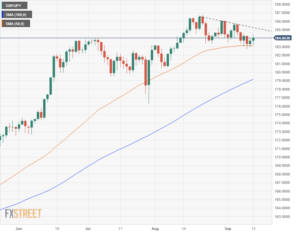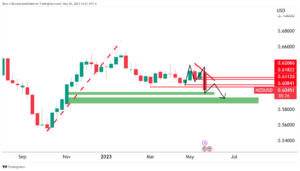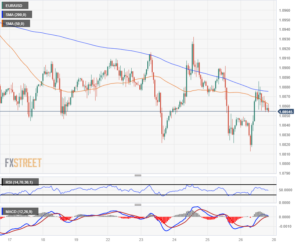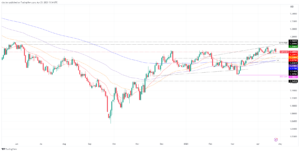
- The US Dollar rallies and holds on to gains after January's US Jobs Report
- Traders see the Greenback head back into the green.
- The US Dollar Index pops over 103 and is on track to break 104 soon.
The US Dollar (USD) is giving traders a run for their money with a brutal reversal in the US Jobs Report aftermath. The staggering print 353,000 was out of its league and contradicts with the more than double increase in US job cuts that was seen earlier on Thursday in the Challenger Job Cuts number for January. Though, the upbeat Average Hourly Wages print jumping from 0.4% to 0.6% means trouble ahead as inflation might be coming back with a vengeance and throw a spanner in the plan of traders that were betting on March or May for a rate cut.
On the economic front, traders have had all the numbers and are sending the Greenback higher. With the upbeat sentiment and slighlty higher inflation forecast, the US Dollar Index is soaring higher and could break 104 any moment. That would mean the US Dollar Index closes off the week near the high where it was at the end of the Federale Reserve's rate decision last Wednesday.
Daily digest market movers: back with a vengeance
- Former US President Donald Trump said once elected, he would replace US Federal Reserve Chairman Jerome Powell.
- Markets will be on the lookout for any headlines on a possible ceasefire in the Middle East or other headlines that could point to military actions from the US against Iraq or Houthi rebels.
- At 13:30 GMT the US Jobs Report for January was released, and what a report it was:
- Nonfarm Payrolls went from a previous 216,000 to 353,000. Though the December number got revised up as well to 333,000.
- Average Hourly Earnings jumped from 0.4% to 0.6% MoM and could mean an uptick in inflation is inbound in the coming months.
- Yearly Average Earnings ticks up as well from 4.1% to 4.5%.
- The US Unemployment rate remains unchanged at 3.7%.
- The University of Michigan numbers for January added fuel to the fire:
- Consumer Sentiment went from 78.8 to 79.
- Inflation Expectations went from 2.8% to 2.9%.
- Equity markets are mildly in the green ahead of the US Jobs Reports with both Japanese indices up near 0.50%. European equities are doing great with the German DAX hitting an alltime high. US equities are recovering from the US Jobs Report and are back in the green.
- The CME Group’s FedWatch Tool is now looking at the March 20th meeting. Expectations for a pause are 63.5%, while 36.5% for a rate cut.
- The benchmark 10-year US Treasury Note shoots higher to 4%, up 10 basis points from its opening price on Friday.
US Dollar Index Technical Analysis: DXY to close the week near or above 104
The US Dollar Index (DXY) is showing off with a staggering performance after the US Jobs Report. Not only is current Nonfarm Payrolls number and the upward revision a catalyst for more US Dollar strength. The fact that Monthly Hourly Wages are ticking up that much as well, means that employers are willing to pay more in order to keep their personal, thus the disinflation might be slowing down or even reversing in the near future.
Should the US Dollar Index be able to recover Thursday’s losses and break away from the 200-day Simple Moving Average (SMA) at 103.55, traders should look to the 100-day SMA near 104.30 as the next level. Should the US Jobs Report see its components all fall in favor of more US Dollar strength, however, expect to see another jump higher to 105.12. That would mean a fresh three-month-high for the DXY.
The 55-day SMA at 103 is under pressure and has already been breached earlier this Friday. Should that last level snap, a nosedive move to 102.00 could very well be in the cards here. Certainly should the US Jobs Report reveal a negative print expect to see substantial US Dollar weakness.
Nonfarm Payrolls FAQs
Nonfarm Payrolls (NFP) are part of the US Bureau of Labor Statistics monthly jobs report. The Nonfarm Payrolls component specifically measures the change in the number of people employed in the US during the previous month, excluding the farming industry.
The Nonfarm Payrolls figure can influence the decisions of the Federal Reserve by providing a measure of how successfully the Fed is meeting its mandate of fostering full employment and 2% inflation.
A relatively high NFP figure means more people are in employment, earning more money and therefore probably spending more. A relatively low Nonfarm Payrolls’ result, on the either hand, could mean people are struggling to find work.
The Fed will typically raise interest rates to combat high inflation triggered by low unemployment, and lower them to stimulate a stagnant labor market.
Nonfarm Payrolls generally have a positive correlation with the US Dollar. This means when payrolls’ figures come out higher-than-expected the USD tends to rally and vice versa when they are lower.
NFPs influence the US Dollar by virtue of their impact on inflation, monetary policy expectations and interest rates. A higher NFP usually means the Federal Reserve will be more tight in its monetary policy, supporting the USD.
Nonfarm Payrolls are generally negatively-correlated with the price of Gold. This means a higher-than-expected payrolls’ figure will have a depressing effect on the Gold price and vice versa.
Higher NFP generally has a positive effect on the value of the USD, and like most major commodities Gold is priced in US Dollars. If the USD gains in value, therefore, it requires less Dollars to buy an ounce of Gold.
Also, higher interest rates (typically helped higher NFPs) also lessen the attractiveness of Gold as an investment compared to staying in cash, where the money will at least earn interest.
Nonfarm Payrolls is only one component within a bigger jobs report and it can be overshadowed by the other components.
At times, when NFP come out higher-than-forecast, but the Average Weekly Earnings is lower than expected, the market has ignored the potentially inflationary effect of the headline result and interpreted the fall in earnings as deflationary.
The Participation Rate and the Average Weekly Hours components can also influence the market reaction, but only in seldom events like the “Great Resignation” or the Global Financial Crisis.
- SEO Powered Content & PR Distribution. Get Amplified Today.
- PlatoData.Network Vertical Generative Ai. Empower Yourself. Access Here.
- PlatoAiStream. Web3 Intelligence. Knowledge Amplified. Access Here.
- PlatoESG. Carbon, CleanTech, Energy, Environment, Solar, Waste Management. Access Here.
- PlatoHealth. Biotech and Clinical Trials Intelligence. Access Here.
- Source: https://www.fxstreet.com/news/us-dollar-has-meltdown-ahead-of-us-jobs-report-202402021230
- :has
- :is
- :not
- :where
- $UP
- 00
- 000
- 10
- 102
- 12
- 13
- 2%
- 2% Inflation
- 20th
- 216
- 30
- 32
- 34
- 35%
- 36
- 4
- 45
- 55
- 8
- a
- Able
- above
- actions
- added
- After
- aftermath
- against
- ahead
- All
- AllTime
- already
- also
- an
- analysis
- and
- Animate
- Another
- any
- ARE
- AS
- At
- average
- away
- back
- basis
- BE
- been
- Benchmark
- Betting
- bigger
- both
- Break
- Bureau
- bureau of labor statistics
- but
- buy
- by
- CAN
- Cards
- Cash
- Catalyst
- certainly
- chairman
- challenger
- change
- Close
- Closes
- CME
- combat
- come
- coming
- Commodities
- compared
- component
- components
- content
- Correlation
- could
- crisis
- Current
- Cut
- cuts
- December
- decision
- decisions
- deflationary
- Digest
- doing
- Dollar
- dollar index
- dollars
- donald
- Donald Trump
- double
- down
- during
- Dxy
- Earlier
- earn
- Earning
- Earnings
- East
- Economic
- effect
- either
- elected
- employed
- employers
- employment
- end
- ends
- Equities
- European
- European equities
- Even
- events
- excluding
- expanded
- expect
- expectations
- expected
- fact
- Fall
- FAQ
- farming
- favor
- Fed
- Federal
- federal reserve
- Federal Reserve Chairman
- Figure
- Figures
- financial
- financial crisis
- Find
- Fire
- For
- Forecast
- fostering
- fresh
- Friday
- from
- front
- Fuel
- full
- future
- Gains
- generally
- German
- Giving
- Global
- global financial
- Global Financial Crisis
- GMT
- Gold
- gold price
- got
- great
- Green
- Greenback
- Group’s
- had
- hand
- Have
- he
- head
- headline
- Headlines
- helped
- here
- High
- High inflation
- higher
- hitting
- holds
- HOURS
- How
- However
- HTTPS
- if
- Impact
- in
- Increase
- index
- Indices
- industry
- inflation
- Inflationary
- influence
- interest
- Interest Rates
- into
- investment
- iraq
- IT
- ITS
- January
- Japanese
- jerome
- jerome powell
- Job
- job cuts
- Jobs
- jobs report
- jpg
- jump
- jumped
- Keep
- labor
- labor market
- Last
- League
- least
- less
- Level
- like
- Look
- looking
- losses
- Low
- lower
- major
- mandate
- March
- Market
- market reaction
- Markets
- May..
- mean
- means
- measure
- measures
- meeting
- Michigan
- Middle
- Middle East
- might
- Military
- module
- mom
- moment
- Monetary
- Monetary Policy
- money
- Month
- monthly
- months
- more
- most
- move
- Movers
- moving
- moving average
- much
- Near
- negative
- next
- nfp
- Nonfarm
- Nonfarm Payrolls
- note
- now
- number
- numbers
- of
- off
- on
- once
- ONE
- only
- opening
- or
- order
- Other
- Ounce of Gold
- out
- over
- part
- participation
- pause
- Pay
- Payrolls
- People
- performance
- personal
- plan
- plato
- Plato Data Intelligence
- PlatoData
- Point
- points
- policy
- Pops
- positive
- possible
- potentially
- Powell
- president
- President Donald Trump
- pressure
- previous
- price
- probably
- providing
- raise
- rallies
- rally
- Rate
- Rates
- reaction
- Recover
- recovering
- relatively
- released
- remains
- replace
- report
- Reports
- requires
- Reserve
- result
- reveal
- Reversal
- Run
- s
- Said
- see
- seen
- seldom
- sending
- sentiment
- should
- showing
- Simple
- Slowing
- SMA
- Snap
- soaring
- Soon
- specifically
- Spending
- staggering
- starts
- statistics
- staying
- stimulate
- strength
- Struggling
- substantial
- Successfully
- Supporting
- Technical
- Technical Analysis
- tends
- than
- that
- The
- the Fed
- their
- Them
- therefore
- they
- this
- though?
- throw
- thursday
- Thus
- ticking
- times
- to
- tool
- track
- Traders
- treasury
- triggered
- trouble
- trump
- typically
- under
- unemployment
- unemployment rate
- university
- University of Michigan
- upbeat
- upward
- us
- US Dollar
- US Dollar Index
- US Dollars
- US Equities
- US Federal
- us federal reserve
- US Jobs Report
- US President
- US Treasury
- US Unemployment Rate
- USD
- usually
- value
- versa
- very
- vice
- wages
- was
- weakness
- Wednesday
- week
- weekly
- WELL
- went
- were
- What
- when
- while
- will
- willing
- with
- within
- Work
- would
- zephyrnet


